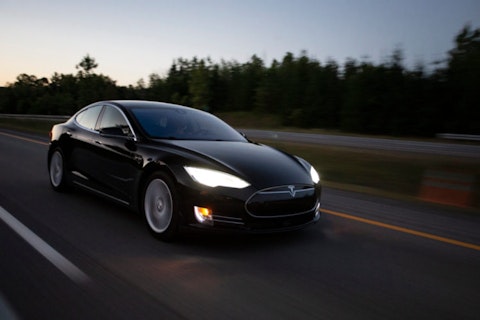In this article, we discuss the 10 most advanced battery technologies that will power the future. If you want to read about some more advanced battery technologies that will power the future, go directly to 5 Most Advanced Battery Technologies That Will Power the Future.
Advanced battery technology involves the use of sophisticated technologies and materials in the design and production of batteries to enhance their performance, efficiency, and durability. This can include a variety of research areas focused on creating batteries with better energy density, lifespan and cost as well as the development of innovative charging methods, such as fast and wireless charging. A few of the advanced battery technologies include silicon and lithium-metal anodes, solid-state electrolytes, advanced Li-ion designs, lithium-sulfur (Li-S), sodium-ion (Na-ion), redox flow batteries (RFBs), Zn-ion, Zn-Br and Zn-air batteries.
Advanced batteries have found several applications in various industries. Currently, they are being used in portable electronic devices, electric and hybrid vehicles, energy storage systems, medical devices, industrial equipment and military applications. For example, Sila Nanotechnologies is working on a new type of lithium-ion battery that uses a silicon-based anode instead of a graphite anode. The company claims that this new type of battery will have a higher energy density and faster charging times compared to traditional lithium-ion batteries. The company aims to increase the energy density of battery cells by 20 to 40%.
The development and use of silicon anodes and Li-metal anodes are two of the most intriguing material advances for Li-ion batteries. The potential for these anode materials to dramatically increase energy density is exciting, however, improvements to rate capability, safety, and even cost are being explored as well. Major lifetime issues with silicon and lithium metal have slowed and restricted commercial usage up to this point. For the Li-S batteries, longevity is even more of a challenge.
Given the significance of the EV sector to the overall global economy, Li-ion tech is anticipated to continue its leadership position in the battery universe for the foreseeable future, even as it is plagued by issues like cathode and anode selection, cell design advancements, and the rate of energy density development. The improvement of one performance parameter, such as energy density, cost, or sustainability, will nearly always come at the price of another. This holds true even when considering battery chemistries other than lithium-based ones.
Energy density is typically sacrificed by alternatives to lithium-based chemistries in favor of greater environmental credentials, reduced capital or lifetime costs, improved rate capability, or longer cycle life. In the end, the requirements of a particular application and market determine the mix of performance characteristics and, consequently, the choice of technology and chemistry. Longer-duration storage methods are increasing in demand, for example, in stationary energy storage. This opens the door for innovations like the redox flow battery, which more readily scales energy capacity while simultaneously enabling the use of inexpensive and widely accessible active materials.
Of course, the EV battery sector is a major focus for many battery technology advancements, providing a chance to serve a market where demand is expected to exceed 1500 GWh by 2030. Throughout the second half of the decade, the EV battery market is expected to place an increased emphasis on silicon anode, lithium-metal, and solid-state technologies. Asia and China now dominate the processing of Li-ion materials and cell production, while the US and Europe in particular are now trying to build and develop their own battery supply chains, setting the pace for innovation and the development of next-generation technologies to capture and domesticate value.
The US is emerging as a leader in next-generation technology when start-up companies are analyzed by geography as a proxy for innovation, while Europe also has significant activity. However, it should be noted that development in Asia is likely under-represented given the greater presence of major battery manufacturers and materials companies in the region. The advanced battery technology market is projected to experience significant growth in the coming years. The market size is expected to increase from $95.7 billion in 2022 to $136.6 billion by 2027, at a compound annual growth rate of 7.4%.
Some of the upcoming trends for 2023 in the advanced battery technology industry are increased use of solid-state technology, integration with renewable energy, and environmentally friendly raw materials. Some of the top firms in this context include Tesla, Inc. (NASDAQ:TSLA), Taiwan Semiconductor Manufacturing Company Limited (NYSE:TSM), and General Motor Company (NYSE:GM). Please see our article about the best battery stocks to buy according to hedge funds.
Our Methodology
These were picked from a careful assessment of the battery industry. The battery technologies that exhibit growth potential based on the viability of their commercial prototypes were preferred for the list. In addition to the advantages offered by various advanced battery technologies, their major drawbacks are also discussed since improvement of one aspect of battery tech usually comes at the cost of another.

Most Advanced Battery Technologies That Will Power the Future
10. New-Generation Lithium-Ion Battery
A conventional lithium-ion battery uses lithium-ion as a key component of its electrochemistry. Lithium atoms in the anode are ionized and are separated from their electrons. The next generation of lithium-ion batteries will work on technological innovations in the cathode, enabling higher energy densities and lower costs. There are three types of lithium-ion batteries which are used in electric vehicles: lithium ferrophosphate, or lithium iron phosphate, lithium nickel manganese cobalt oxide and lithium nickel cobalt aluminum oxide.
Despite the advantages of eco-friendliness and lower working potential, conventional graphite anode in lithium batteries is facing challenges, such as the limited capacity to fulfill the requirements of emerging trends of electric cars and hybrid vehicles. Next-generation lithium-ion batteries with higher density have novel anode materials. These batteries have the potential to exhibit higher energy capacity and better cycling durability than conventional graphite. Currently, various prelithiation methods for compensating the anode’s initial irreversible capacity have been found. However, large-scale commercial applications have not been developed yet. See a list of the 12 countries that produce the most lithium in the world.
Firms like Tesla, Inc. (NASDAQ:TSLA), Taiwan Semiconductor Manufacturing Company Limited (NYSE:TSM), and General Motor Company (NYSE:GM) are aiding the development of new battery tech like this.
9. Lithium-Sulfur Battery
In lithium-sulfur batteries, the positive electrode is sulfur and the negative electrode is made up of metallic lithium. The cell voltage is comparatively lower than lithium-ion cells and is about 2 V.
These batteries have an energy density several times higher than lithium-ion batteries. Li-S have specific energies on the order of 550 Wh/kg. Contrary to that, conventional lithium-ion batteries have a range of 150-260 Wh/kg.
The sulfur used as a cathode in lithium-sulfur batteries is less expensive than the cobalt used in conventional lithium-ion batteries. These batteries are in higher demand in future because of their greater energy storage and cost efficiency.
Lithium-sulfur batteries have a major drawback: they are reusable for around 1000 charge cycles whereas lithium-ion batteries can be recharged 2000 – 3000 times. Lithium-sulfur batteries with more than 1500 charge and discharge cycles were presented in 2017 but their cycle life test at a commercial scale with lean electrolyte is yet to be demonstrated.
8. Saltwater Battery
A saltwater battery has a concentrated saline solution as its electrodes. The water molecules pull the sodium and chloride ions apart, making them free-floating. Sodium is extracted from the solution while charging the battery and the extracted salt water is discharged with oxygen dissolved in it. This functions as an oxidant to produce electricity.
Unlike conventional lithium-ion batteries, these batteries don’t use flammable electrolytes which makes them much safer and easier to manufacture, use and recycle. Researchers have discovered that saline solution displays an electrochemical stability of up to 2.6 volts. Saltwater batteries can be recharged for 5000 cycles during their lifespan. However, these batteries can be used beyond the indicated cycles as they are inflammable and non-explosive.
Having a high energy density, they can power electronic devices for a longer duration. However, in order to achieve that density level, batteries are required to be built bigger and require more materials. This, in turn, increases the production cost as well as the size of saltwater batteries. Therefore, these batteries are not being used commercially.
7. Solid State Battery
Unlike conventional lithium batteries, which use liquid and polymer gel electrolytes, solid-state batteries use solid electrodes and a solid electrolyte made up of ceramics such as oxides, glass and sulfides etc. These batteries have a higher energy density than lithium-ion batteries and could be recharged up to seven times with a life span of ten years.
Solid-state batteries can decrease the carbon footprint of an electric vehicle by 24%. Research has shown that the use of additional materials in these batteries can further reduce the carbon footprint of an EV by 39%. They are also being used in pacemakers, RFID tags and wearable devices.
Toyota Motor is considered the leader in solid-state battery patents. Currently, EVs with solid-state batteries are not commercially available but are expected to be used in EVs from 2025. Moreover, solid-states are being tested in EVs by BMW and Ford. Major companies in the solid-state market are Robert Bosch, Cymbet, BrightVolt, Samsung SDI, QuantumScape, SolidEnergy Systems and Toyota Motor Corporation etc.
6. Cobalt-Free Lithium-ion Battery
Cobalt, which is a key element in producing conventional lithium-ion batteries, is considered an expensive metal. Additionally, 50-60% of the worldwide cobalt resources are located in the politically unstable Congo (DRC) and are extracted by questionable working conditions. Cobalt-free batteries provide a solution to this problem by using alternative materials as the cathode in lithium-ion batteries.
Cobalt-free lithium-ion chemistries include lithium ferrous phosphate and lithium titanate. Manganese and nickel are also used as electrode metals for cobalt-free batteries. These alternatives are less expensive than standard cobalt-based batteries. Nickel-based ion batteries have a higher energy density than cobalt-based batteries which means that it consumes less space and has higher energy. Cobalt-free batteries are also less toxic to the environment.
Tesla, a major EV manufacturer, stated that almost all cars produced in the first quarter were using cobalt-free iron-phosphate batteries. SVOLT, another EV battery manufacturer, is making cobalt-free batteries using nickel and manganese. The cathode material used by the company contains 75% nickel and 25% manganese.
Companies like like Tesla, Inc. (NASDAQ:TSLA), Taiwan Semiconductor Manufacturing Company Limited (NYSE:TSM), and General Motor Company (NYSE:GM) are aiding the development of new battery tech like this.
Click to continue reading and see 5 Most Advanced Battery Technologies That Will Power the Future.
Suggested Articles:
- 11 Best Low Risk Dividend Stocks To Invest In
- 15 Biggest Nanotechnology Companies in the World
- 11 Best Pet Stocks To Buy
Disclosure. None. 10 Most Advanced Battery Technologies That Will Power The Future is originally published on Insider Monkey.





